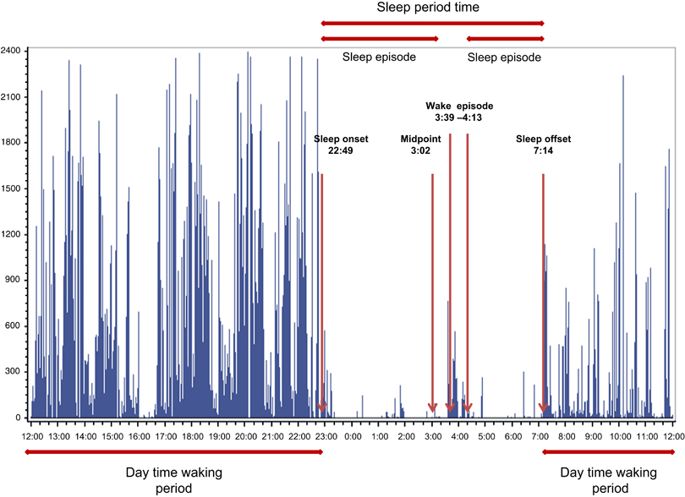International Journal of Obesity Supplements Pub Date : 2015-12-08 , DOI: 10.1038/ijosup.2015.19 C Tudor-Locke , , E F Mire , T V Barreira , J M Schuna , J-P Chaput , M Fogelholm , G Hu , A Kurpad , R Kuriyan , E V Lambert , C Maher , J Maia , V Matsudo , T Olds , V Onywera , O L Sarmiento , M Standage , M S Tremblay , P Zhao , T S Church , P T Katzmarzyk

|
Objectives:
We describe the process of identifying and defining nocturnal sleep-related variables (for example, movement/non-movement indicators of sleep efficiency, waking episodes, midpoint and so on) using the unique 24-h waist-worn free-living accelerometer data collected in the International Study of Childhood Obesity, Lifestyle and the Environment (ISCOLE).
Methods:
Seven consecutive days of 24-h waist-worn accelerometer (GT3X+, ActiGraph LLC) data were collected from over 500 children at each site. An expert subgroup of the research team with accelerometry expertize, frontline data collectors and data managers met on several occasions to categorize and operationally define nocturnal accelerometer signal data patterns. The iterative process was informed by the raw data drawn from a sub set of the US data, and culminated in a refined and replicable delineated definition for each identified nocturnal sleep-related variable. Ultimately based on 6318 participants from all 12 ISCOLE sites with valid total sleep episode time (TSET), we report average clock times for nocturnal sleep onset, offset and midpoint in addition to sleep period time, TSET and restful sleep efficiency (among other derived variables).
Results:
Nocturnal sleep onset occurred at 2218 hours and nocturnal sleep offset at 0707 hours. The mean midpoint was 0243 hours. The sleep period time of 529.6 min (8.8 h) was typically accumulated in a single episode, making the average TSET very similar in duration (529.0 min). The mean restful sleep efficiency ranged from 86.8% (based on absolute non-movement of 0 counts per minute) to 96.0% (based on relative non-movement of <100 counts per minute).
Conclusions:
These variables extend the potential of field-based 24-h waist-worn accelerometry to distinguish and categorize the underlying robust patterns of movement/non-movement signals conveying magnitude, duration, frequency and periodicity during the nocturnal sleep period.
中文翻译:

24小时自由活动腰间穿戴式加速度计的夜间睡眠相关变量:儿童肥胖,生活方式和环境的国际研究
目标:
我们使用收集的独特的24小时腰穿自由活动加速度计数据来描述识别和定义夜间睡眠相关变量(例如,睡眠效率的运动/非运动指标,清醒发作,中点等)的过程。在《儿童肥胖,生活方式和环境国际研究》(ISCOLE)中获得博士学位。
方法:
连续7天的24小时腰戴式加速度计(GT3X +,ActiGraph LLC)数据来自每个地点的500多个儿童。具有加速度测量技术的研究团队的一个专家小组专门研究,一线数据收集人员和数据管理人员在不同场合举行了会议,以对夜间加速度计信号数据模式进行分类和操作定义。迭代过程的依据是从美国数据子集中获取的原始数据,并最终为每个识别的夜间睡眠相关变量提供了精炼且可复制的轮廓定义。最终根据来自所有12个ISCOLE站点的6318名参与者的有效总睡眠发作时间(TSET),我们报告了夜间睡眠发作,偏移和中点的平均时钟时间,以及睡眠时间,TSET和安宁的睡眠效率(以及其他衍生变量) )。
结果:
夜间睡眠发作发生在2218小时,夜间睡眠偏移发生在0707小时。平均中点是0243小时。一次发作通常会累积529.6分钟(8.8小时)的睡眠时间,这使得平均TSET持续时间(529.0分钟)非常相似。平均安静的睡眠效率在86.8%(基于每分钟0个计数的绝对不移动)到96.0%(基于每分钟<100个计数的相对不移动)之间。
结论:
这些变量扩展了基于场的24小时腰部加速度计的潜力,以区分和分类在夜间睡眠期间传达幅度,持续时间,频率和周期性的运动/非运动信号的基本鲁棒模式。











































 京公网安备 11010802027423号
京公网安备 11010802027423号